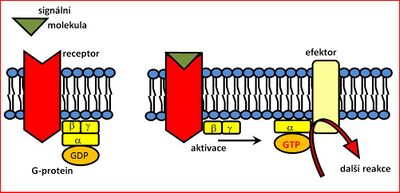G-protein
G-protein is a regulatory protein that mediates the connection between an information molecule bound to a membrane receptor (e.g. enzyme or membrane channel). It is located on the inside of the cytoplasmatic membrane, where it is bound by means of lipid anchors (covalently bound fatty acids or izoprenoids). It got its name because it has the ability to bind guanosine nucleotides (GTP or GDP)).
G-protein structure[edit | edit source]
It consists of three subunits – α, β and γ. The alpha subunit binds the nucleotide and ensures the reaction between the receptor and the effector, the β and γ subunits also have the ability to activate various effectors. The alpha subunit with bound GDP is in the inactive state, while the GTP-bound α subunit is in the active state.
Binding of a ligand to a receptor coupled to a G-protein causes a change in the conformation of this receptor and this leads to activation of the G-protein (by exchanging GDP for GTP on the α subunit). Activation of the G-protein leads to the separation of the α subunit from binding with the β and γ subunits. The beta and γ subunits are tightly linked to form the βγ complex. This results in two separate molecules that can diffuse across the plasma membrane and activate different effectors (e.g. adenylate cyclase or phospholipase C). G-protein activation is terminated by the hydrolysis of GTP na GDP a P, which is caused by the internal GTPase activity of the α subunit of the G-protein. Hydrolysis terminates signaling and reassociates all three subunits.
G-protein function[edit | edit source]
G-proteins influence the production of second messengers. There are many different G-proteins that differ in their α subunit and the way they affect cellular effectors. Stimulatory G-proteins (Gs) stimulate adenylate cyclase to produce cAMP, meanwhile inhibitory G-proteins (Gi) inhibit cAMP production through adenylate cyclase. Other G-proteins (Gq) activate phospholipase C to produce diacylglycerol and inositol-1,4,5,-triphosphate. The specific G-protein transducin can be found in the eye.
Links[edit | edit source]
Related articles[edit | edit source]
External links[edit | edit source]
Sources[edit | edit source]
- ŠVÍGLEROVÁ, Jitka. G-protein [online]. The last revision 18. 2. 2009, [cit. 12.11.2010]. <https://web.archive.org/web/20160416212514/http://wiki.lfp-studium.cz/index.php/G-protein>.
- MATOUŠ, Bohuslav, et al. Základy lékařské chemie a biochemie. 1. edition. Praha : Galén, 2010. 540 pp. ISBN 978-80-7262-702-8.

